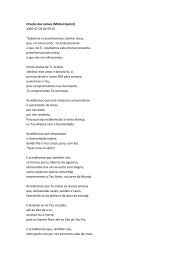Long-Pulsed Nd:YAG Laser-Assisted Hair Removal in Pigmented Skin
Long-Pulsed Nd:YAG Laser-Assisted Hair Removal in Pigmented Skin
Long-Pulsed Nd:YAG Laser-Assisted Hair Removal in Pigmented Skin
You also want an ePaper? Increase the reach of your titles
YUMPU automatically turns print PDFs into web optimized ePapers that Google loves.
<strong>Long</strong>-<strong>Pulsed</strong> <strong>Nd</strong>:<strong>YAG</strong> <strong>Laser</strong>-<strong>Assisted</strong><br />
<strong>Hair</strong> <strong>Removal</strong> <strong>in</strong> <strong>Pigmented</strong> Sk<strong>in</strong><br />
A Cl<strong>in</strong>ical and Histological Evaluation<br />
STUDY<br />
T<strong>in</strong>a S. Alster, MD; Holly Bryan, BS; Carmen M. Williams, MD<br />
Objective: To determ<strong>in</strong>e the safety and effectiveness of<br />
a long-pulsed <strong>Nd</strong>:<strong>YAG</strong> laser at 1064 nm <strong>in</strong> effect<strong>in</strong>g longterm<br />
hair reduction <strong>in</strong> patients with darkly pigmented<br />
sk<strong>in</strong>.<br />
Design: Nonrandomized before-after cl<strong>in</strong>ical and histological<br />
trial.<br />
Sett<strong>in</strong>g: Private practice, ambulatory care facility.<br />
Patients: Twenty women with sk<strong>in</strong> phototypes IV<br />
through VI and dark brown to black term<strong>in</strong>al hair on the<br />
face, axillae, or legs.<br />
Intervention: A series of 3 long-pulsed (50-<br />
millisecond) 1064-nm <strong>Nd</strong>:<strong>YAG</strong> laser treatments at fluences<br />
rang<strong>in</strong>g from 40 to 50 J/cm 2 were delivered to the<br />
identified treatment areas on a monthly basis by a s<strong>in</strong>gle<br />
operator.<br />
Ma<strong>in</strong> Outcome Measures: Global cl<strong>in</strong>ical grad<strong>in</strong>g<br />
scores of comparable before-after treatment photographs<br />
were determ<strong>in</strong>ed by 2 <strong>in</strong>dependent medical assessors<br />
dur<strong>in</strong>g each laser session and 1, 3, 6, and 12 months<br />
postoperatively. A dermatopathologist reviewed unmarked<br />
histological specimens obta<strong>in</strong>ed at basel<strong>in</strong>e, immediately<br />
after the <strong>in</strong>itial laser treatment, and at 1 and 6<br />
months after the f<strong>in</strong>al laser session.<br />
Results: Substantial hair reduction was seen after each<br />
of the 3 treatment sessions. Prolonged hair loss was observed<br />
12 months after the f<strong>in</strong>al laser treatment (70%-<br />
90% hair reduction). Axillary hair was substantially more<br />
responsive to laser irradiation than was hair located on<br />
the legs and face. Adverse effects <strong>in</strong>cluded mild to moderate<br />
treatment pa<strong>in</strong> and rare occurrences of vesiculation<br />
and transient pigmentary alteration without fibrosis<br />
or scarr<strong>in</strong>g. Histological tissue changes mirrored cl<strong>in</strong>ical<br />
response rates, with evidence of selective follicular <strong>in</strong>jury<br />
without epidermal disruption.<br />
Conclusion: The long-pulsed 1064-nm <strong>Nd</strong>:<strong>YAG</strong> laser is<br />
a safe and effective method of long-term hair reduction<br />
<strong>in</strong> patients with darkly pigmented sk<strong>in</strong>.<br />
Arch Dermatol. 2001;137:885-889<br />
From the Wash<strong>in</strong>gton Institute<br />
of Dermatologic <strong>Laser</strong> Surgery,<br />
Wash<strong>in</strong>gton, DC.<br />
THE CLINICAL results achieved<br />
by laser hair-removal systems<br />
s<strong>in</strong>ce 1995 constitute<br />
an impressive but essentially<br />
qualified success. The<br />
difficulty <strong>in</strong> permanently disrupt<strong>in</strong>g hair<br />
growth through laser irradiation results<br />
from the superlative ability for follicular<br />
self-repair and regeneration and from the<br />
vary<strong>in</strong>g anatomical locations, sizes, depths,<br />
and melan<strong>in</strong> concentrations of hair.<br />
Further complicat<strong>in</strong>g the process, it is not<br />
yet known which portion of the hair follicle<br />
is primarily responsible for hair growth<br />
and whether the <strong>in</strong>tegrity of the entire follicular<br />
epithelium is essential to the hair<br />
growth process. Because of these uncerta<strong>in</strong>ties,<br />
current laser hair-removal systems<br />
are designed to irradiate as much of<br />
the follicle as possible. Thus, only lasers<br />
emitt<strong>in</strong>g energy with wavelengths rang<strong>in</strong>g<br />
from 630 to 1100 nm are potentially capable<br />
of irradiat<strong>in</strong>g the entire length of anagen<br />
hair follicles, which typically extend 2<br />
to 5 mm <strong>in</strong>to the dermis.<br />
Although several dermatologic lasers<br />
meet the wavelength criteria for effect<strong>in</strong>g<br />
selective follicular destruction, the<br />
treatment of darker sk<strong>in</strong> phototypes is particularly<br />
problematic because follicular<br />
melan<strong>in</strong> serves as the <strong>in</strong>tended chromophore<br />
for laser epilation. Thus, absorption<br />
of laser energy by the targeted hairs<br />
is compromised by an <strong>in</strong>creased concentration<br />
of epidermal melan<strong>in</strong> <strong>in</strong> these patients.<br />
To reduce epidermal energy absorption<br />
relative to follicular absorption,<br />
longer-wavelength lasers are best used. The<br />
1064-nm <strong>Nd</strong>:<strong>YAG</strong> laser can penetrate from<br />
5 to 7 mm <strong>in</strong>to the dermis, depths more<br />
(REPRINTED) ARCH DERMATOL / VOL 137, JULY 2001 WWW.ARCHDERMATOL.COM<br />
885<br />
Downloaded from www.archdermatol.com on April 7, 2008<br />
©2001 American Medical Association. All rights reserved.
MATERIALS AND METHODS<br />
Twenty women (aged 21-39 years) with unwanted dark<br />
brown to black term<strong>in</strong>al hairs and sk<strong>in</strong> phototypes IV<br />
to VI were <strong>in</strong>cluded <strong>in</strong> the study after <strong>in</strong>formed consent<br />
was obta<strong>in</strong>ed. Three consecutive, long-pulsed (50-<br />
millisecond) 1064-nm <strong>Nd</strong>:<strong>YAG</strong> laser treatments were<br />
delivered on a monthly basis to the <strong>in</strong>volved treatment<br />
areas by a s<strong>in</strong>gle operator (T.S.A.). Immediately<br />
before each treatment, hairs longer than 1 mm were<br />
shaved close to the sk<strong>in</strong> us<strong>in</strong>g a safety razor. No topical<br />
cool<strong>in</strong>g gel or anesthetic cream was used. A contact<br />
sapphire-tipped cool<strong>in</strong>g device was used to protect<br />
the sk<strong>in</strong> dur<strong>in</strong>g laser irradiation with a rhomboid<br />
scanner that placed adjacent nonoverlapp<strong>in</strong>g 5-mm<br />
spots over the treatment area (Lyra; <strong>Laser</strong>Scope, San<br />
Jose, Calif). Facial hair was treated with a mean fluence<br />
of 40 J/cm 2 <strong>in</strong> 8 patients. A mean fluence of 50<br />
J/cm 2 was used to treat axillary hair <strong>in</strong> 8 patients,<br />
whereas a mean fluence of 45 J/cm 2 was used on the<br />
legs <strong>in</strong> 4 patients (Table). Photographs us<strong>in</strong>g identical<br />
light<strong>in</strong>g, patient position<strong>in</strong>g, and camera equipment<br />
were obta<strong>in</strong>ed of all treatment sites before each<br />
of the 3 treatment sessions and at 1, 3, 6, and 12 months<br />
after the f<strong>in</strong>al treatment.<br />
Global cl<strong>in</strong>ical evaluations of hair loss and extent<br />
of hair regrowth us<strong>in</strong>g side-by-side comparison<br />
photographs were performed by 2 <strong>in</strong>dependent medical<br />
assessors at each visit with the use of the follow<strong>in</strong>g<br />
hair reduction grad<strong>in</strong>g system: 0 <strong>in</strong>dicates less than<br />
25%; 1, 25% to 50%; 2, 51% to 75%; 3, 76% to 90%;<br />
and 4, greater than 90%. Subjective patient reports<br />
and adverse effects were also recorded at each follow-up<br />
visit.<br />
Three-millimeter sk<strong>in</strong> punch biopsy specimens<br />
were taken from with<strong>in</strong> each of the 3 different<br />
treatment areas (face, axilla, and leg) at basel<strong>in</strong>e, immediately<br />
after laser irradiation, and 1 and 6 months<br />
after the f<strong>in</strong>al laser treatment <strong>in</strong> 3 patients. Histological<br />
evaluations were performed by a boardcertified<br />
dermatopathologist unaware of the study<br />
protocol (C.M.W.).<br />
than sufficient to reach the base of the bulb <strong>in</strong> most anatomical<br />
areas, and would thus be expected to produce<br />
sufficient follicular <strong>in</strong>jury with less epidermal damage <strong>in</strong><br />
patients with pigmented sk<strong>in</strong>. It would also be anticipated<br />
that significantly fewer <strong>in</strong>stances of crust<strong>in</strong>g, vesiculation,<br />
dyspigmentation, and other adverse epidermal<br />
effects would occur with 1064-nm <strong>Nd</strong>:<strong>YAG</strong> laser<br />
irradiation. The purpose of this study was to determ<strong>in</strong>e<br />
the efficacy and safety profile of a long-pulsed (50-<br />
millisecond) 1064-nm <strong>Nd</strong>:<strong>YAG</strong> laser for hair reduction<br />
<strong>in</strong> patients with dark sk<strong>in</strong> tones.<br />
RESULTS<br />
A marked reduction <strong>in</strong> hair regrowth was noted after each<br />
of the 3 treatment sessions and persisted for 12 months<br />
after the f<strong>in</strong>al treatment <strong>in</strong> all body locations studied<br />
(Figure 1and Figure 2). Cl<strong>in</strong>ical hair reduction scores<br />
on the face averaged 1.8 after 1 treatment, 2.3 after 2 treatments,<br />
2.9 after 3 treatments, and 3.1, 2.5, and 2.3 at 3,<br />
6, and 12 months, respectively, after the third treatment.<br />
<strong>Hair</strong> on the legs was slightly more responsive, with<br />
cl<strong>in</strong>ical hair reduction scores of 2.0, 3.2, and 3.5 at 1<br />
month after each of the 3 treatments, and 3.3, 3.0, and<br />
2.9 at 3, 6, and 12 months, respectively, after the f<strong>in</strong>al<br />
laser session. Axillary hair demonstrated the most impressive<br />
hair reduction scores, averag<strong>in</strong>g 2.8 after 1 treatment,<br />
3.6 after 2 treatments, and 4.0 at 1 and 3 months,<br />
3.8 at 6 months, and 3.5 at 12 months after the third treatment<br />
(Figure 3).<br />
Adverse effects (calculated from all 60 treatment sessions)<br />
were limited to mild to moderate treatment pa<strong>in</strong><br />
<strong>in</strong> 90% of treatment sites, transient pigmentary alteration<br />
<strong>in</strong> 5% (exposed facial or leg areas only; average duration,<br />
4 weeks), and vesiculation <strong>in</strong> 1.5%. Fibrosis and<br />
scarr<strong>in</strong>g were not seen <strong>in</strong> any treatment site as a result<br />
of laser irradiation.<br />
Histological changes mirrored cl<strong>in</strong>ical response rates,<br />
with evidence of selective follicular <strong>in</strong>jury without epidermal<br />
disruption. Destruction of large term<strong>in</strong>al hair follicles<br />
was evident with m<strong>in</strong>imal <strong>in</strong>flammation, reduced<br />
numbers of hair shafts, and preservation of pilosebaceous<br />
glands at 6 months after the series of 3 laser treatments.<br />
(Figure 4).<br />
COMMENT<br />
<strong>Laser</strong> hair-removal systems are typically grouped <strong>in</strong>to the<br />
follow<strong>in</strong>g 3 categories on the basis of the type of laser or<br />
light source each uses: red-light systems (694-nm ruby),<br />
<strong>in</strong>frared-light systems (755-nm alexandrite, 800-nm diode,<br />
and 1064-nm <strong>Nd</strong>:<strong>YAG</strong>), and <strong>in</strong>tense pulsed-light<br />
sources (590- to 1200-nm). Although technological advances<br />
of laser-assisted hair removal dur<strong>in</strong>g the past 5<br />
years have been highly gratify<strong>in</strong>g, the rapidity of development<br />
has not been entirely without drawbacks. Specifically,<br />
none of the systems are able to produce consistent,<br />
absolutely predictable results, as follicular<br />
responses to laser irradiation vary considerably from patient<br />
to patient, from one anatomical site to another, and<br />
from one treatment time to another for any given <strong>in</strong>dividual.<br />
Compared with other cutaneous organelles, hair<br />
follicles represent a unique challenge for implementation<br />
of the theory of selective photothermolysis, based<br />
largely on the fact that it rema<strong>in</strong>s unclear which portion<br />
of the follicle is the preferred target to effect hair destruction.<br />
Despite this monumental obstacle, most of the<br />
available lasers and <strong>in</strong>tense light sources can achieve a<br />
marked delay <strong>in</strong> the regrowth of unwanted hair (typically<br />
3-9 months), although longer delays have been<br />
observed. 1-11 In addition, laser-assisted hair removal is<br />
associated with low treatment discomfort, and large body<br />
areas can be treated expeditiously, s<strong>in</strong>ce follicles need<br />
not be targeted <strong>in</strong>dividually (as is the case with electrolysis).<br />
12,13 Paramount to the success and acceptability<br />
of lasers for epilation has been the substantial safety<br />
marg<strong>in</strong> afforded by most systems, with transient and mild<br />
adverse effects be<strong>in</strong>g normal. 14<br />
Ideal candidates for laser-assisted hair removal have<br />
traditionally <strong>in</strong>cluded those <strong>in</strong>dividuals with pale sk<strong>in</strong><br />
(REPRINTED) ARCH DERMATOL / VOL 137, JULY 2001 WWW.ARCHDERMATOL.COM<br />
886<br />
Downloaded from www.archdermatol.com on April 7, 2008<br />
©2001 American Medical Association. All rights reserved.
Patient Characteristics and Global Cl<strong>in</strong>ical Grades<br />
Patient No. Sk<strong>in</strong> Type Fluence, J/cm 2 *<br />
Status After Treatment, Grade*<br />
1 mo After Third Treatment<br />
First Treatment Second Treatment 1 mo 3 mo 6 mo 12 mo<br />
Face<br />
1 V 40 2.0 2.5 3.0 3.5 3.0 3.0<br />
2 V 40 1.5 2.0 2.5 2.5 2.0 2.0<br />
3 IV 45 2.5 3.0 3.5 4.0 4.0 3.0<br />
4 V 40 2.0 2.5 3.0 3.0 2.5 2.5<br />
5 VI 35 2.0 2.0 2.5 3.0 2.0 2.0<br />
6 V 40 2.0 2.5 3.0 3.0 2.5 2.0<br />
7 V 40 1.5 2.0 3.0 3.0 2.0 2.0<br />
8 V 40 1.0 2.0 2.5 2.5 2.0 2.0<br />
Mean . . . 40 1.8 2.3 2.9 3.1 2.5 2.3<br />
Axilla<br />
9 IV 50 2.5 3.0 4.0 4.0 4.0 3.5<br />
10 IV 45 2.0 3.0 4.0 4.0 3.0 3.0<br />
11 V 50 3.0 4.0 4.0 4.0 4.0 4.0<br />
12 V 50 3.0 3.5 4.0 4.0 4.0 3.0<br />
13 V 50 3.0 4.0 4.0 4.0 4.0 4.0<br />
14 V 50 3.0 3.5 4.0 4.0 3.5 3.0<br />
15 VI 55 3.0 4.0 4.0 4.0 4.0 4.0<br />
16 V 50 3.0 4.0 4.0 4.0 4.0 3.5<br />
Mean . . . 50 2.8 3.6 4.0 4.0 3.8 3.5<br />
Leg<br />
17 V 40 2.0 3.0 3.0 3.0 3.0 3.0<br />
18 V 45 2.0 3.5 4.0 3.5 3.0 3.0<br />
19 IV 45 2.0 3.0 3.0 3.0 3.0 2.5<br />
20 IV 50 2.0 3.5 4.0 4.0 3.0 3.0<br />
Mean . . . 45 2.0 3.2 3.5 3.4 3.0 2.9<br />
*Zero <strong>in</strong>dicates less than 25% reduction; 1, 25% to 50% reduction; 2, 51% to 75% reduction; 3, 76% to 90% reduction; 4, greater than 90 reduction; and<br />
ellipses, not applicable.<br />
A<br />
B<br />
C<br />
D<br />
Figure 1. Facial hair before treatment (A) and 1 month after second 1064-nm <strong>Nd</strong>:<strong>YAG</strong> (50-millisecond) laser treatment at an average fluence of 40 J/cm 2 (B). One<br />
(C) and 6 (D) months after the third treatment, prolonged hair reduction is seen.<br />
(REPRINTED) ARCH DERMATOL / VOL 137, JULY 2001 WWW.ARCHDERMATOL.COM<br />
887<br />
Downloaded from www.archdermatol.com on April 7, 2008<br />
©2001 American Medical Association. All rights reserved.
A<br />
B<br />
C<br />
D<br />
Figure 2. Axillary hair before treatment (A) and 1 month after first 1064-nm <strong>Nd</strong>:<strong>YAG</strong> laser treatment at 50 J/cm 2 (B). Further hair loss was seen 1 month after the<br />
second (C) and 6 months after the third (D) treatment session.<br />
Face Leg Axilla<br />
Grade<br />
4.0<br />
3.5<br />
3.0<br />
2.5<br />
2.0<br />
1.8 2.0 2.8<br />
2.3<br />
3.6<br />
3.2<br />
2.9<br />
4.0<br />
3.5<br />
3.1 3.3 4.0<br />
2.5<br />
3.0<br />
3.8<br />
1.5<br />
1.0<br />
0.5<br />
0.0<br />
First<br />
Treatment, 1<br />
Second<br />
Treatment, 1<br />
Third<br />
Treatment, 1<br />
Time After <strong>Laser</strong> Treatment, mo<br />
Third<br />
Treatment, 3<br />
Third<br />
Treatment, 6<br />
Figure 3. <strong>Hair</strong> reduction scores. Zero <strong>in</strong>dicates less than 25%; 1, 25% to<br />
50%; 2, 51% to 75%; 3, 76% to 90%; and 4, greater than 90%.<br />
2tones and dark term<strong>in</strong>al hair. The relatively high concentration<br />
of melan<strong>in</strong> <strong>in</strong> hair follicles compared with the<br />
epidermis <strong>in</strong> these patients ensures a high level of efficacy<br />
and target-specific energy absorption when pigmentspecific<br />
lasers are used. In patients with dark sk<strong>in</strong> tones,<br />
however, epidermal energy absorption cannot be entirely<br />
avoided us<strong>in</strong>g any of the aforementioned systems.<br />
Thus, the rate of adverse effects is apt to be higher <strong>in</strong> these<br />
patients, lead<strong>in</strong>g to the reluctance of many practitioners<br />
to avoid treatment of ethnic sk<strong>in</strong>, despite the fact that<br />
A<br />
Figure 4. A, Term<strong>in</strong>al hairs are evident <strong>in</strong> pigmented sk<strong>in</strong> before laser<br />
irradiation. B, Six months after 3 consecutive 1064-nm <strong>Nd</strong>:<strong>YAG</strong> laser<br />
treatments, pilosebaceous glands and epidermal pigmentation rema<strong>in</strong> <strong>in</strong>tact,<br />
but reduced term<strong>in</strong>al hairs are seen (hematoxyl<strong>in</strong>-eos<strong>in</strong>, orig<strong>in</strong>al<br />
magnification 10).<br />
unwanted hair <strong>in</strong> these patients tends to be darker, thicker,<br />
and more cosmetically conspicuous.<br />
The <strong>Nd</strong>:<strong>YAG</strong> laser has been of particular <strong>in</strong>terest <strong>in</strong><br />
the field of laser-assisted hair removal because of its early<br />
<strong>in</strong>troduction (<strong>in</strong> a short-pulsed or Q-switched mode) 4,15,16<br />
and its known high safety profile. 14 This latter attribute is<br />
particularly important when <strong>in</strong>dividuals with darker sk<strong>in</strong><br />
tones seek treatment. Previous reports of long-pulsed <strong>Nd</strong>:<br />
<strong>YAG</strong> laser treatment <strong>in</strong> patients with dark sk<strong>in</strong> phototypes<br />
have been limited by their short postoperative evaluations<br />
and/or limited treatment sessions but have<br />
substantiated its use <strong>in</strong> these <strong>in</strong>dividuals, nonetheless. 17,18<br />
Not surpris<strong>in</strong>gly, the longer-pulse (millisecond) <strong>Nd</strong>:<strong>YAG</strong><br />
B<br />
(REPRINTED) ARCH DERMATOL / VOL 137, JULY 2001 WWW.ARCHDERMATOL.COM<br />
888<br />
Downloaded from www.archdermatol.com on April 7, 2008<br />
©2001 American Medical Association. All rights reserved.
system has been shown to be more effective <strong>in</strong> safely remov<strong>in</strong>g<br />
hair than has the Q-switched (nanosecond) <strong>Nd</strong>:<br />
<strong>YAG</strong> system, given its closer approximation to the target<br />
hair follicle’s thermal relaxation time. 19 It is likely that with<br />
equivalent fluences, shorter-pulse red and <strong>in</strong>frared laser systems<br />
can also permanently destroy hair follicles, albeit at<br />
the expense of the epidermis. The use of lasers with longer<br />
pulse durations (200 milliseconds) permit safe application<br />
of higher fluences to patients with darker sk<strong>in</strong> tones,<br />
effectively heat<strong>in</strong>g the <strong>in</strong>ner and outer root sheaths and the<br />
germ<strong>in</strong>ative zone without disrupt<strong>in</strong>g epidermal melanosomes<br />
(which typically respond to short [1-millisecond]<br />
pulses). 20 Selective bulb and stem cell damage can thus be<br />
achieved with pulse durations much greater than the relaxation<br />
times of follicles (10-100 milliseconds).<br />
The results of our study support the safe and effective<br />
use of the long-pulsed 1064-nm <strong>Nd</strong>:<strong>YAG</strong> laser for<br />
long-term epilation <strong>in</strong> darkly pigmented patients. They<br />
also provide <strong>in</strong>formation about variations <strong>in</strong> cl<strong>in</strong>ical response<br />
at different body locations. Specifically, areas characterized<br />
by th<strong>in</strong>ner sk<strong>in</strong> (eg, axillae) were more responsive<br />
to laser treatment than those with thicker sk<strong>in</strong> (eg,<br />
ch<strong>in</strong> and legs), suggest<strong>in</strong>g that sk<strong>in</strong> thickness rather than<br />
hair growth cycle <strong>in</strong>fluences cl<strong>in</strong>ical outcomes. With thick<br />
sk<strong>in</strong>, it may become difficult to achieve adequate penetration<br />
of energy deep <strong>in</strong>to the follicle. Body location<br />
was further highlighted as an important consideration,<br />
as transient pigmentary alteration and vesiculation were<br />
limited to areas more prone to sun exposure (eg, face and<br />
legs, rather than axillae).<br />
CONCLUSIONS<br />
<strong>Long</strong>-pulsed (50-millisecond) 1064-nm <strong>Nd</strong>:<strong>YAG</strong> laser irradiation<br />
can achieve rates of hair reduction equivalent<br />
to those of other long-pulsed red and <strong>in</strong>frared laser and<br />
<strong>in</strong>tense pulsed-light systems. In addition, the use of a longpulsed<br />
<strong>Nd</strong>:<strong>YAG</strong> laser at high fluences can effectively treat<br />
patients with darker sk<strong>in</strong> tones while produc<strong>in</strong>g few adverse<br />
posttreatment sequelae. Sun-protected and th<strong>in</strong>ner<br />
axillary sk<strong>in</strong> showed greater cl<strong>in</strong>ical response to and<br />
fewer adverse effects of laser treatment than did sunexposed<br />
facial and leg sk<strong>in</strong>.<br />
Accepted for publication December 27, 2000.<br />
Correspond<strong>in</strong>g author and repr<strong>in</strong>ts: T<strong>in</strong>a S. Alster, MD,<br />
2311 M St NW, Suite 200, Wash<strong>in</strong>gton, DC 20037.<br />
REFERENCES<br />
1. Nanni CA, Alster TS. A practical review of laser-assisted hair removal us<strong>in</strong>g the<br />
Q-switched <strong>Nd</strong>:<strong>YAG</strong>, long-pulsed ruby, and long-pulsed alexandrite lasers. Dermatol<br />
Surg. 1998;24:1399-1405.<br />
2. Dierickx C. <strong>Laser</strong>-assisted hair removal: state of the art. Dermatol Ther. 2000;<br />
13:80-89.<br />
3. Grossman MC, Dierickx C, Far<strong>in</strong>elli W, Flotte T, Anderson RR. Damage to hair<br />
follicles by normal-mode ruby laser irradiation. J Am Acad Dermatol. 1996;35:<br />
889-894.<br />
4. Nanni CA, Alster TS. Optimiz<strong>in</strong>g treatment parameters for hair removal us<strong>in</strong>g a<br />
topical carbon-based solution and 1064-nm Q-switched neodymium:<strong>YAG</strong> laser<br />
energy. Arch Dermatol. 1997;133:1546-1549.<br />
5. Lask G, Elman M, Slatk<strong>in</strong>e M, et al. <strong>Laser</strong>-assisted hair removal by selective<br />
photothermolysis: prelim<strong>in</strong>ary results. Dermatol Surg. 1997;23:737-739.<br />
6. Gold MH, Bell MW, Foster TD, Street S. <strong>Long</strong>-term epilation us<strong>in</strong>g the EpiLight<br />
broad band, <strong>in</strong>tense pulsed light hair removal system. Dermatol Surg. 1997;23:<br />
909-913.<br />
7. Dierickx CC, Grossman M, Far<strong>in</strong>elli WA, Anderson RR. Permanent hair removal<br />
by normal-mode ruby laser. Arch Dermatol. 1998;134:837-842.<br />
8. Rogers CJ, Glaser DA, Siegfried EC, Walsh PM. <strong>Hair</strong> removal us<strong>in</strong>g topical suspension-assisted<br />
Q-switched <strong>Nd</strong>:<strong>YAG</strong> and long-pulsed alexandrite lasers: a comparative<br />
study. Dermatol Surg. 1999;25:844-850.<br />
9. Johnson F, Dovale M. Intense pulsed light treatment of hirsutism: case reports<br />
of sk<strong>in</strong> phototypes V and VI. J Cutan <strong>Laser</strong> Ther. 1999;1:233-237.<br />
10. Garcia C, Alamoudi H, Makib M, Zimmo S. Alexandrite laser hair removal is safe<br />
for Fitzpatrick sk<strong>in</strong> types IV-VI. Dermatol Surg. 2000;26:130-134.<br />
11. Nanni CA, Alster TS. <strong>Long</strong>-pulsed alexandrite laser-assisted hair removal: comparisons<br />
at 5, 10, and 20 millisecond pulse durations. <strong>Laser</strong>s Surg Med. 1999;<br />
24:332-337.<br />
12. Marchell NL, Alster TS. Evaluation of temporary and permanent hair removal methods.<br />
J Aesthetic Dermatol Cosmetic Dermatol Surg. 1999;1:3-12.<br />
13. Olsen E. Methods of hair removal. J Am Acad Dermatol. 1999;40:143-155.<br />
14. Nanni CA, Alster TS. Complications of laser-assisted hair removal us<strong>in</strong>g the<br />
Q-switched <strong>Nd</strong>:<strong>YAG</strong>, long-pulsed ruby, and long-pulsed alexandrite laser. JAm<br />
Acad Dermatol. 1999;41:165-171.<br />
15. Goldberg DJ, Littler CM, Wheeland RG. Topical suspension-assisted<br />
Q-switched <strong>Nd</strong>:<strong>YAG</strong> laser hair removal. Dermatol Surg. 1997;23:741-745.<br />
16. Kol<strong>in</strong>ko VG, Littler CM, Cole A. Influence of the anagen:telogen ratio on<br />
Q-switched <strong>Nd</strong>:<strong>YAG</strong> laser hair removal efficacy. <strong>Laser</strong>s Surg Med. 2000;26:<br />
33-40.<br />
17. Benc<strong>in</strong>i PL, Luci A, Galimberti M, Ferranti G. <strong>Long</strong>-term epilation with longpulsed<br />
neodimium:<strong>YAG</strong> laser. Dermatol Surg. 1999;25:175-178.<br />
18. Goldberg DJ, Samady JA. Evaluation of a long-pulse Q-switched <strong>Nd</strong>:<strong>YAG</strong> laser<br />
for hair removal. Dermatol Surg. 2000;26:109-113.<br />
19. Parrish JA. New concepts <strong>in</strong> therapeutic photomedic<strong>in</strong>e: photochemistry, optical<br />
target<strong>in</strong>g and the therapeutic w<strong>in</strong>dow. J Invest Dermatol. 1981;77:45-50.<br />
20. Battle EF, Suthamjariya K, Alora MB, et al. Very long-pulsed (20-200 ms) diode<br />
laser for hair removal on all sk<strong>in</strong> types [abstract]. <strong>Laser</strong>s Surg Med. 2000;(suppl<br />
12):21.<br />
(REPRINTED) ARCH DERMATOL / VOL 137, JULY 2001 WWW.ARCHDERMATOL.COM<br />
889<br />
Downloaded from www.archdermatol.com on April 7, 2008<br />
©2001 American Medical Association. All rights reserved.
















